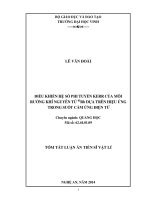Section 3 6 TRƯỜNG ĐIỆN TỪ
Bạn đang xem bản rút gọn của tài liệu. Xem và tải ngay bản đầy đủ của tài liệu tại đây (83.79 KB, 11 trang )
Slide Presentations for ECE 329,
Introduction to Electromagnetic Fields,
to supplement “Elements of Engineering
Electromagnetics, Sixth Edition”
by
Nannapaneni Narayana Rao
Edward C. Jordan Professor of Electrical and Computer Engineering
University of Illinois at Urbana-Champaign, Urbana, Illinois, USA
Distinguished Amrita Professor of Engineering
Amrita Vishwa Vidyapeetham, Coimbatore, Tamil Nadu, India
3.6
Polarization of Sinusoidally
Time-Varying Fields
3.6-3
Polarization is the characteristic which describes
how the position of the tip of the vector varies
with time.
Linear Polarization:
Tip of the vector
describes a line.
Circular Polarization:
Tip of the vector
describes a circle.
3.6-4
Elliptical Polarization:
Tip of the vector
describes an ellipse.
(i) Linear Polarization
F1 F1 cos (t ) a x
Magnitude varies
sinusoidally with time
Direction remains
along the x axis
Linearly polarized in the x direction.
3.6-5
F2 F2 cos (t ) a y
Magnitude varies
sinusoidally with time
Direction remains
along the y axis
Linearly polarized in the y direction.
If two (or more) component linearly polarized vectors
are in phase, (or in phase opposition), then their sum
vector is also linearly polarized.
Ex: F F1 cos (t ) a x F2 cos (t ) a y
3.6-6
y
F2
F
F1
x
F2 cos (t )
–1
tan
F1 cos (t )
F2
–1
tan
F1
constant
(ii) Circular Polarization
If two component linearly polarized vectors are
(a) equal to amplitude
(b) differ in direction by 90˚
(c) differ in phase by 90˚,
then their sum vector is circularly polarized.
3.6-7
Example:
F F1 cos t ax F1 sin t a y
F
F1 cos t F1 sin t
2
2
F1 , constant
tan
tan
1
1
F1 sin t
F1 cos t
tan t t
y
F2
F
F1
x
3.6-8
(iii) Elliptical Polarization
In the general case in which either of (i) or (ii) is not
satisfied, then the sum of the two component
linearly polarized vectors is an elliptically polarized
vector.
Ex: F F1 cos t a x F2 sin t a y
y
F2
F
F1
x
3.6-9
Example: F F0 cos t a x F0 cos (t 4)a y
y
F0
F2
F
/4
–F0
–F0
F1 F 0 x
3.6-10
D3.17
F1 F0 cos 2 108t 2 z ax
F2 F0 cos 2 108t 3 z a y
F1 and F2 are equal in amplitude (= F0) and differ in
direction by 90˚. The phase difference (say ) depends
on z in the manner –2z – (–3z) = z.
(a)
At (3, 4, 0), = (0) = 0.
F1 F2 is linearly polarized.
(b)
At (3, –2, 0.5), = (0.5) = 0.5 .
F1 F2 is circularly polarized.
3.6-11
(c)
At (–2, 1, 1), = (1) = .
F1 F2 is linearly polarized.
(d)
At (–1, –3, 0.2) = = (0.2) = 0.2.
F1 F2 is elliptically polarized.









